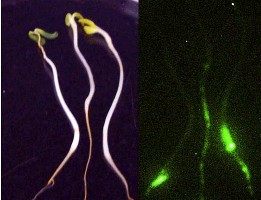
Both images show plants grown in an agar substrate with a bioluminescent E. coli, which emits light when active. The E. coli associated with the roots on the right are glowing when viewed in the dark. (Bruce Applegate, Purdue University)
A study at Purdue University in West Lafayette, Indiana shows the bacteria Escherichia coli (E. coli) can live for weeks around the roots of produce plants and transfer to the edible portions. Researchers discovered, however, that the threat can be minimized if growers don’t harvest affected crops too soon.
E. coli make up a large and diverse group of bacteria. Although most strains of E. coli are harmless, others can make you sick. Some kinds of E. coli can cause diarrhea, while others cause urinary tract infections, respiratory illness and pneumonia, and other illnesses. Among the sources of E. coli are contaminated water and food, including produce.
Purdue scientists added E. coli to soil through manure application and water treated with manure and showed that the bacteria can survive and are active in the area around the plant roots, of lettuce and radishes, called the rhizosphere. E. coli eventually gets onto the above-ground surfaces of the plants, where it can live for several weeks. Activity in the rhizosphere was observed using a bioluminescent E. coli that glows when active (pictured right), created by Purdue food science and biological sciences professor Bruce Applegate.
Ron Turco, a professor of agronomy at Purdue and co-author of the study with Applegate, noted that the E. coli didn’t survive on the plants’ surfaces more than 40 days after seeds were planted. Harvesting produce at least 40 days after planting, the authors concluded, should reduce the possibility of contamination, but they warned that E. coli could still come from other sources.
The authors advise applying manure to fields well in advance of planting and harvesting. Turco said a wait of 90-120 days between manure application and harvesting, with a minimum of 40 days between planting and harvesting, should minimize the chance of E. coli contamination.
The research was funded by U.S. Department of Agriculture and findings were published in the Journal of Food Protection (paid subscription required).
* * *

 RSS - Posts
RSS - Posts
You must be logged in to post a comment.